At the Doctor's ESL Worksheets, Role-Plays, Games & Activities
Do you concur?
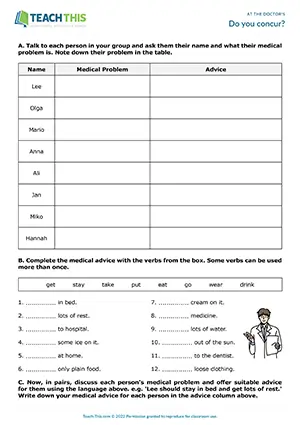
ESL At the Doctor's Activity - Vocabulary and Speaking: Role-Play, Asking and Answering Questions, Gap-fill, Discussion, Writing Sentences - Group and Pair Work
In this useful medical advice activity, students practice talking about basic medical issues and giving corresponding advice. First, in groups, students take on...
Symptoms and Advice

ESL At the Doctor's Worksheet - Vocabulary and Reading Exercises: Categorizing, Matching - Speaking Activity: Role-Play, Freer Practice - Pair Work
This comprehensive 'At the Doctor's' worksheet helps students practice vocabulary and language for describing symptoms and giving medical advice...
At the Doctor's Discussion
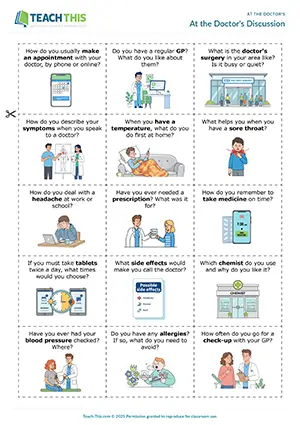
ESL At the Doctor's Activity - Speaking: Asking and Answering Questions, Guided Discussion, Freer Practice - Group Work
In this visiting the doctor discussion activity, students practice healthcare vocabulary and talk about doctor visits, describing symptoms, medicines, and ways to manage common health issues. In groups, students...
What are your symptoms?

ESL At the Doctor's Worksheet - Vocabulary Exercises: Matching, Gap-fill - Speaking Activity: Role-Play, Discussion, Controlled and Freer Practice - Pair Work
This 'At the Doctor's' worksheet helps students learn and practice medical vocabulary for visiting the doctor. First, students read eight...
Advice for Aches and Pains

ESL Health Advice Game - Vocabulary: Matching - Speaking Activity: Role-Play, Communicative Practice - Pair Work
In this free giving health advice game and role-play, students match pictures to health problems and health problems to treatments, then role-play giving health advice as a doctor. In pairs, students...
Medical Vocabulary
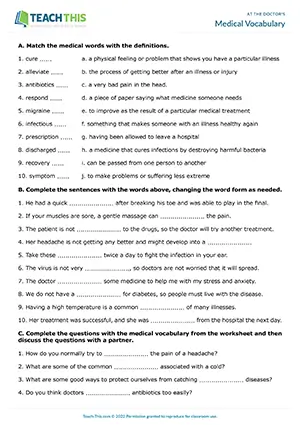
ESL Medical Vocabulary Worksheet - Vocabulary Exercises: Matching, Gap-fill - Speaking Activity: Asking and Answering Questions, Freer Practice - Pair Work
Here is a productive medical vocabulary worksheet for upper-intermediate students. Students begin by matching medical words to their definitions. Next...
Remedy Race
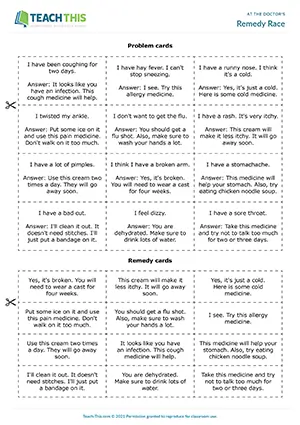
ESL At the Doctor's Game - Speaking: Matching, Role-Play, Communicative Practice - Group Work
In this free doctor and patient role-play game, students race to suggest remedies to health issues. In groups of three, students take turns taking on the role of a patient and picking up a health problem card. The...
Diagnosis Detective

ESL Medical Vocabulary Activity - Vocabulary, Reading and Speaking: Gap-fill, Information Gap, Matching, Asking and Answering Questions, Controlled Practice
In this medical vocabulary activity, students complete sentences about patients' symptoms and exchange information to diagnose each person's...
Medical Conditions and Symptoms
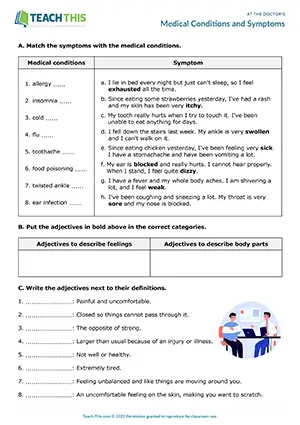
ESL Health Vocabulary Worksheet - Vocabulary Exercises: Matching, Categorising, Gap-fill
In this insightful health vocabulary worksheet, students practice words related to medical conditions and symptoms. To begin, students match symptoms with medical conditions. Next, students put adjectives...
Visiting the Doctor

ESL At the Doctor's Worksheet - Vocabulary Exercises: Gap-fill, Reading Comprehension, Categorising, Matching - Speaking Activity: Freer Practice - Pair Work
In this engaging 'At the Doctor's' worksheet, students practice vocabulary and language related to health, illness, and medical consultations. First...

